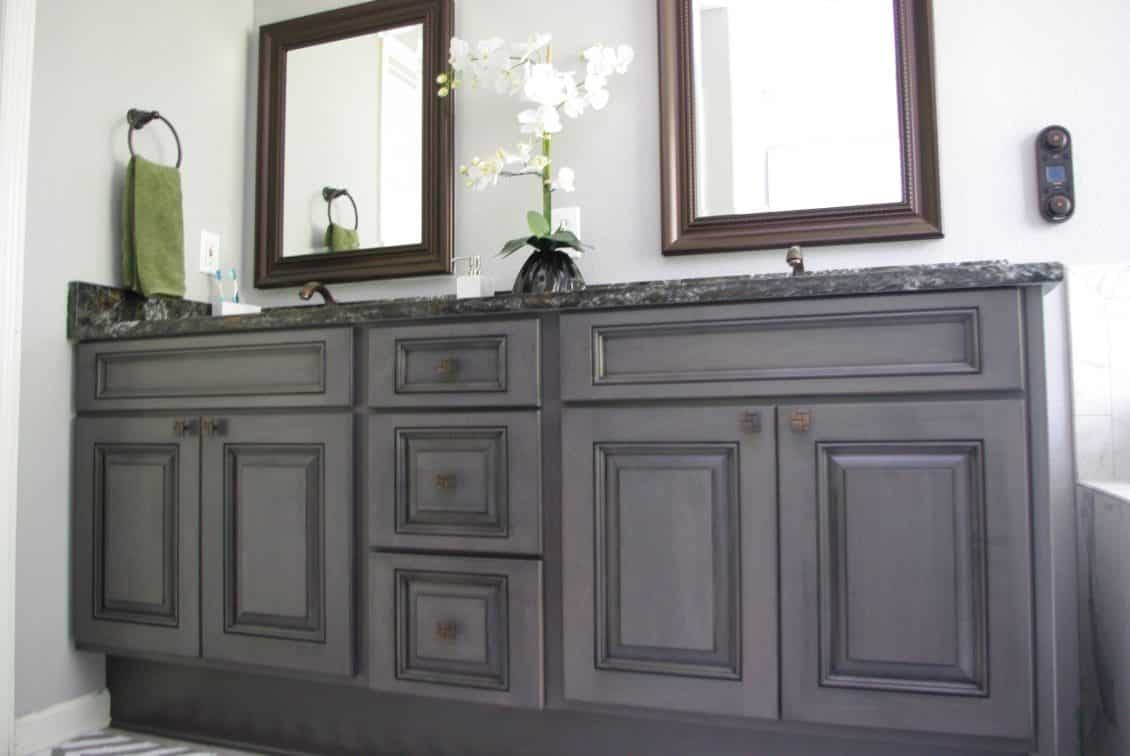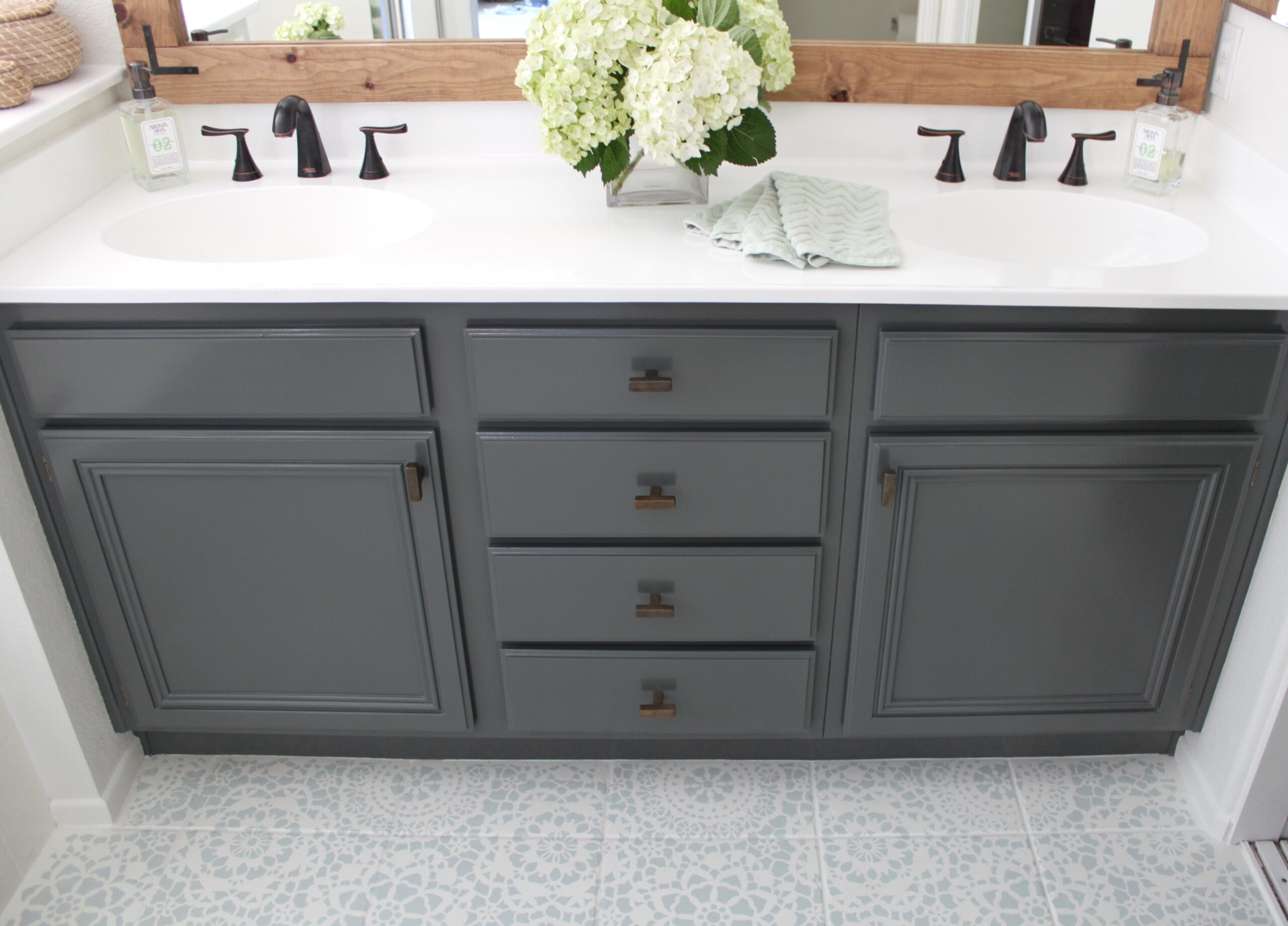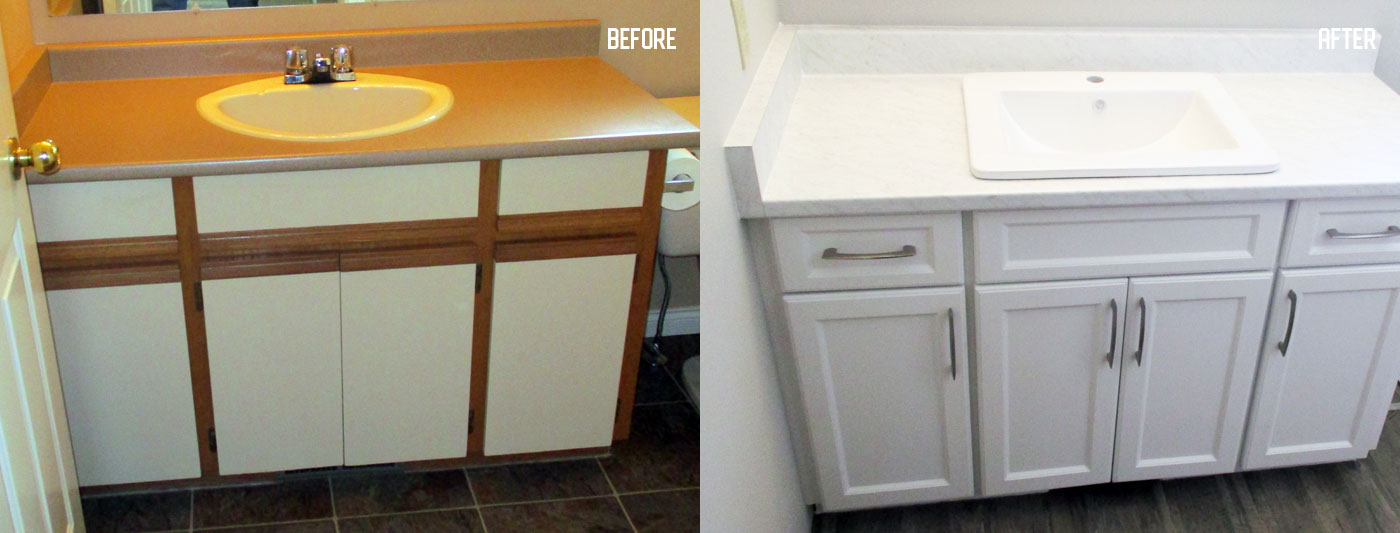The Benefits of Refacing Bathroom Cabinet Doors
Refacing bathroom cabinet doors is a popular home improvement choice for many homeowners. It involves updating the exterior appearance of your cabinets without having to replace the entire unit. Here are the top benefits of refacing your bathroom cabinet doors:
- Cost-Effective Solution: Refacing is significantly cheaper than completely replacing your cabinets. While new cabinets can cost thousands of dollars, refacing usually costs a fraction of that amount. This makes it an attractive option for budget-conscious homeowners looking to update their bathrooms without breaking the bank.
- Time-Saving: Refacing bathroom cabinet doors is a quicker process compared to a full cabinet replacement. Typically, refacing can be completed within a few days, whereas replacing cabinets can take weeks. This means less disruption to your daily life and a faster turnaround time for enjoying your newly updated bathroom.
- Eco-Friendly Option: By refacing your existing cabinet doors, you’re reducing waste and the demand for new materials. This is an environmentally friendly choice, as it prevents old cabinets from ending up in landfills and reduces the carbon footprint associated with manufacturing new cabinets.
- Customization and Variety: Refacing allows for a high level of customization. You can choose from a wide range of materials, colors, and finishes to match your style and the overall decor of your bathroom. This flexibility ensures that you can achieve the exact look you want without compromising.
- Preserves Cabinet Layout: If you’re satisfied with the current layout and functionality of your bathroom cabinets, refacing is a perfect solution. It preserves the existing structure while giving it a fresh, updated appearance. This is especially beneficial if your cabinets are in good condition but just need a visual upgrade.
- Increases Home Value: Updating your bathroom can significantly increase the value of your home. A modern, well-maintained bathroom is a key selling point for potential buyers. Refacing your cabinet doors is a cost-effective way to enhance your bathroom’s appeal and, consequently, your home’s market value.

Materials and Finishes: Choosing the Right Look for Your Bathroom
Selecting the right materials and finishes for your bathroom cabinet doors is crucial to achieving the desired look and functionality. Here’s a guide to help you make the best choices:
Solid Wood
Solid wood is a classic choice for bathroom cabinet doors, offering durability and a timeless aesthetic. Options include oak, maple, cherry, and walnut. Each type of wood has unique grain patterns and colors, allowing for a natural and elegant appearance that can be stained or painted to suit your preferences.
Laminate
Laminate is a cost-effective and versatile material. It comes in a wide range of colors and patterns, including options that mimic the look of wood or stone. Laminate is also easy to clean and resistant to moisture, making it ideal for bathroom environments. It’s a great choice if you’re looking for a modern, low-maintenance option.
Thermofoil
Thermofoil is a vinyl material that is heat-sealed onto MDF (medium-density fiberboard). It provides a smooth, durable finish that is easy to clean and moisture-resistant. Thermofoil cabinet doors are available in various colors and styles, including high-gloss and matte finishes. This material is perfect for achieving a sleek, contemporary look.
Glass Inserts
Adding glass inserts to your cabinet doors can create a stylish and open feel in your bathroom. Frosted, textured, or stained glass options provide privacy while still allowing light to pass through. Glass inserts can be combined with wood or laminate frames for a custom, elegant appearance.
Metal Finishes
For a modern, industrial look, consider metal finishes such as stainless steel or brushed nickel. These materials are durable and resistant to moisture, making them ideal for bathroom use. Metal cabinet doors can add a sleek, sophisticated touch to your bathroom design.
Painted Finishes
Painting your cabinet doors is a simple way to refresh their look. You can choose any color to match your bathroom’s decor. High-quality paint provides a durable, washable surface that can withstand the humidity and wear and tear of a bathroom environment. This option allows for endless customization and easy updates in the future.
Step-by-Step Guide to Refacing Your Bathroom Cabinet Doors
Refacing your bathroom cabinet doors is a manageable DIY project that can transform your bathroom’s appearance. Follow this step-by-step guide to achieve professional-looking results:
Preparation and Planning
Start by measuring your existing cabinet doors and drawers to determine the sizes of the new materials you’ll need. Decide on the new finish or material you want to use. Gather all necessary tools and materials, including screwdrivers, sandpaper, adhesive, and the new cabinet door skins or veneers.
Remove Cabinet Doors and Hardware
Use a screwdriver to remove the cabinet doors and all hardware, including hinges and handles. Label each door and its corresponding location to make reinstallation easier. Place the doors on a flat surface for the refacing process.
Clean and Sand Surfaces
Thoroughly clean the cabinet doors and frames to remove any grease, dirt, or residue. Use a mild detergent and water, then let them dry completely. Lightly sand the surfaces to ensure better adhesion of the new material. Wipe away any dust with a tack cloth.
Apply New Veneer or Skins
Cut the new veneer or skins to the appropriate sizes for your cabinet doors and frames. Apply adhesive to the back of the veneer and press it onto the cabinet door, starting from the center and working outward to eliminate air bubbles. Use a roller or squeegee to ensure a smooth, even application.
Trim and Finish Edges
Once the veneer is securely in place, use a sharp utility knife to trim any excess material from the edges. Sand the edges lightly to smooth them out. If necessary, apply edge banding to cover the exposed edges for a polished finish.
Reinstall Doors and Hardware
After the new veneer or skins have fully adhered and dried, reattach the cabinet doors to the frames using the labeled hinges and screws. Install new or existing handles and knobs to complete the look. Check that all doors open and close smoothly.
Cost Comparison: Refacing vs. Replacing Bathroom Cabinets
Deciding whether to reface or replace your bathroom cabinets involves considering each option’s costs, benefits, and potential drawbacks. Here’s a detailed cost comparison to help you make an informed decision:
Initial Costs
Refacing bathroom cabinet doors typically costs between $1,000 and $3,000, depending on the materials and finishes chosen. In contrast, replacing bathroom cabinets can range from $4,000 to $15,000 or more, depending on the bathroom size and the quality of the new cabinets. Refacing is clearly the more budget-friendly option for those looking to update their bathroom without significant financial investment.
Labor and Installation
Labor costs for refacing are generally lower than for replacing cabinets. Refacing is a less invasive process that can be completed in a few days, whereas replacing cabinets involves removing the old units, potentially modifying plumbing and electrical systems, and installing the new cabinets. These additional steps increase both the time and labor costs associated with replacement.
Material Costs
The cost of materials for refacing, such as veneers, laminates, and new hardware, is typically less than the cost of new cabinets. High-quality veneers and finishes can give your bathroom a fresh, modern look at a fraction of the price of new cabinets. Additionally, refacing allows you to keep the existing cabinet structure, saving on the cost of new materials.
Customization and Upgrades
While refacing offers a wide range of customization options in terms of colors, finishes, and hardware, replacing cabinets provides the opportunity to completely redesign the layout and functionality of your bathroom. If you want to change the configuration or add new features like pull-out shelves or specialized storage, replacement may be the better option despite the higher cost.
Longevity and Durability
Refaced cabinets can last for many years if done correctly and maintained properly. However, new cabinets may offer superior durability and longer lifespan due to modern construction techniques and materials. If your existing cabinets are structurally sound, refacing can provide a renewed appearance without compromising longevity.
Value Addition
Both refacing and replacing cabinets can increase your home’s value, but the extent of the increase depends on the quality of the work and the materials used. Refacing is a cost-effective way to enhance your bathroom’s appeal, while replacing cabinets can offer a higher return on investment if the new design significantly improves functionality and aesthetics.
DIY Tips for a Successful Bathroom Cabinet Door Reface Project
Embarking on a DIY bathroom cabinet door refacing project can be rewarding and cost-effective. Here are essential tips to ensure your project’s success:
Plan and Prepare Thoroughly
Begin by measuring your cabinet doors and planning the materials you’ll need. Choose your new veneers, laminates, or paint colors in advance. Gather all necessary tools, including a screwdriver, sandpaper, adhesive, utility knife, and a roller. Having everything ready before you start will make the process smoother.
Remove and Label Doors and Hardware
Carefully remove each cabinet door and all hardware. Label each door with its corresponding location to make reinstallation easier. Place the doors on a flat work surface, ensuring they are clean and free of grease or dirt. This step will help you stay organized and prevent mistakes during reinstallation.
Prepare Surfaces Properly
Clean the cabinet doors and frames thoroughly with a mild detergent and water. Once dry, sand the surfaces lightly to remove any gloss and create a better bond for the new material. Wipe away any dust with a tack cloth. Proper surface preparation is crucial for the adhesive to work effectively.
Apply Veneer or Laminate Carefully
Cut the new veneer or laminate to the correct sizes for your cabinet doors. Apply adhesive to the back of the material and press it onto the door, starting from the center and smoothing outwards to remove air bubbles. Use a roller or squeegee to ensure an even application. Precision in this step will result in a professional finish.
Trim Edges Neatly
Once the new material is in place, use a sharp utility knife to trim any excess from the edges. Sand the edges lightly to smooth them out. If using edge banding, apply it to cover any exposed edges. Neatly trimmed edges will enhance the overall appearance of your refaced cabinet doors.
Reinstall with Care
After the adhesive has fully dried, reattach the cabinet doors to their respective locations using the labeled hardware. Install new or existing handles and knobs. Ensure that all doors open and close smoothly. Taking care during reinstallation will ensure that your refaced cabinet doors look and function well.
Maintaining and Caring Tips
Proper maintenance and care for your newly refaced bathroom cabinets will keep them looking fresh and extend their lifespan. Here’s how to do it effectively:
Regular Cleaning
Clean your refaced cabinet doors regularly to prevent the buildup of dust, grime, and moisture. Use a soft cloth and a mild detergent mixed with water. Avoid abrasive cleaners or scrubbers that can damage the finish. Regular cleaning will help maintain the appearance and hygiene of your bathroom cabinets.
Avoid Excess Moisture
While bathroom environments are inherently moist, it’s important to minimize direct water exposure to your cabinet doors. Wipe up any water spills immediately and ensure good ventilation to reduce humidity levels. Using exhaust fans can help keep moisture levels in check and prevent damage to the refaced surfaces.
Handle with Care
Avoid slamming cabinet doors and drawers, as this can cause wear and tear over time. Use gentle pressure when opening and closing to prevent stress on the hinges and the refaced surfaces. Installing soft-close mechanisms can also help prolong the life of your cabinets by reducing impact.
Protect from Heat and Chemicals
Keep your refaced cabinet doors away from direct heat sources like hairdryers or curling irons. Additionally, avoid exposing them to harsh chemicals such as bleach or ammonia-based cleaners. These substances can damage the finish and reduce the lifespan of the refaced surfaces.
Touch-Up and Repair
Minor scratches or chips can be repaired with touch-up kits available from your refacing material supplier. For more significant damage, you may need to replace a section of the veneer or laminate. Addressing damage promptly will help maintain the integrity and appearance of your refaced cabinet doors.
Regular Inspections
Periodically check the condition of your cabinet doors, hinges, and handles. Tighten any loose screws and make sure all components are functioning correctly. Regular inspections will help you catch and address issues early, ensuring your refaced cabinets remain in top condition for years to come.
Introduction to Refacing – Peel and Stick Refacing – Reface Supplies
Fluted Bathroom Cabinet Refacing DIY – at home with Ashley
Cabinet Refacing and Refinishing
Cabinet Replacing or Refacing: Which is a Cheaper Option for You
Bathrooms Redo kitchen cabinets, Bathroom vanity makeover
How to Reface a Bathroom Vanity Cabinet Dowelmax
Related Posts:
- Brushed Nickel Bathroom Cabinet
- Bathroom Cabinet Hardware Images
- Compact Corner Bathroom Cabinet
- Bathroom Cabinet Color Trends
- Miller Bathroom Cabinets
- How To Paint Your Bathroom Cabinets
- Bathroom Cabinets Floor Standing White
- Tall Swivel Bathroom Cabinet
- Summit Bathroom Cabinet
- Infinity Mirror Bathroom Cabinet










